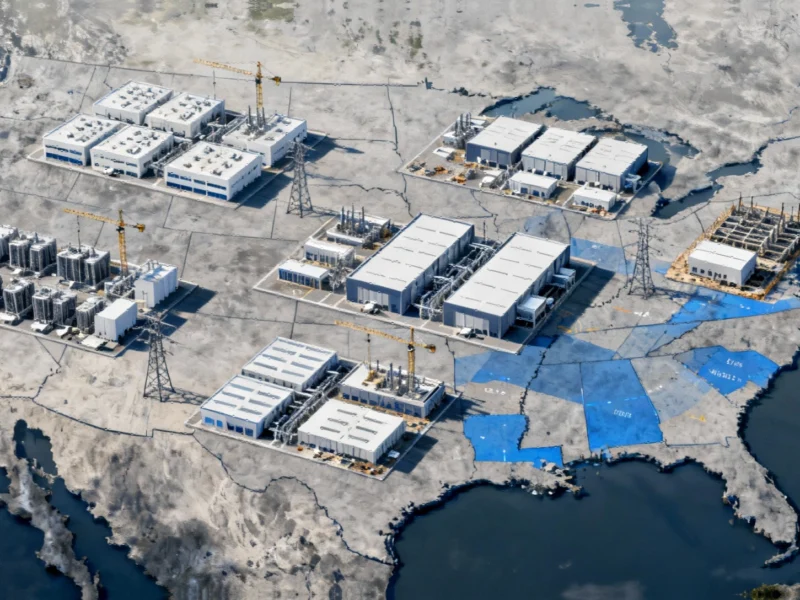Note: Featured image is for illustrative purposes only and does not represent any specific product, service, or entity mentioned in this article.
The New Standard in Data Center Infrastructure
Hyperscale data center operators are driving a fundamental shift in rack infrastructure standards, with the 21-inch format rapidly emerging as the preferred choice for next-generation facilities. According to industry analysis, this larger rack specification is projected to constitute over 70% of equipment shipped by 2030, marking a significant departure from the century-old 19-inch standard that has dominated the industry.
The transition represents more than just a dimensional change—it’s a strategic response to the escalating cooling demands of modern computing workloads, particularly artificial intelligence and high-performance computing applications that generate unprecedented thermal loads.
Historical Context and Industry Evolution
The 19-inch rack standard predates modern computing, with origins tracing back to railway relay circuits before being adopted by telecommunications and eventually the IT industry. However, as computing density increased exponentially, the limitations of this legacy standard became increasingly apparent.
Facebook (now Meta) initiated the movement toward larger formats in 2012 through the Open Compute Project (OCP), recognizing that traditional racks were constraining innovation in thermal management and power distribution. Today, all major cloud providers—including Microsoft, Amazon, Google, Meta, ByteDance, Huawei, and Oracle—have standardized on 21-inch racks for their data center operations.
Huawei demonstrated early leadership in this transition, announcing its commitment to 21-inch rack infrastructure back in 2019. This forward-thinking approach to hyperscale data centers shift to 21-inch rack standards has positioned the company at the forefront of infrastructure innovation.
Technical Advantages Driving Adoption
The move to wider rack formats delivers multiple critical benefits for modern data center operations:
- Enhanced Thermal Management: The additional width enables improved airflow dynamics and accommodates larger fan arrays, directly addressing the cooling challenges posed by high-density computing.
- Advanced Cooling Integration: The expanded space facilitates more sophisticated cooling solutions, including direct-to-chip liquid cooling systems essential for AI-optimized infrastructure.
- Power Distribution Capabilities: The format provides necessary room for high-capacity power distribution units and supporting infrastructure.
- Future-Proof Design: Equipment designed for 19-inch racks remains compatible with 21-inch frames, ensuring backward compatibility while enabling forward progress.
Industry-Wide Implementation Trends
Traditional server manufacturers are rapidly adapting to this shift. Dell Technologies and Hewlett Packard Enterprise have embraced the OCP’s modular server architecture, known as the Data Center Modular Hardware System (DC-MHS). This approach treats each component as a swappable module, enabling seamless upgrades while maintaining consistent I/O configurations.
The trend toward rack-scale designs is accelerating, with entire pre-assembled racks of IT equipment becoming deployable units. Nvidia’s DGX GB200 NVL72 system exemplifies this approach, representing the cutting edge of recent technology implementations in hyperscale environments.
Market Forces and Investment Patterns
Omdia’s research reveals that AI servers now account for 66% of overall server spending, reflecting the massive infrastructure investments by hyperscalers and specialized AI cloud providers. This spending concentration has accelerated the adoption of 21-inch racks, as these major purchasers standardize on the format that best supports their technical requirements.
The infrastructure transformation coincides with broader industry developments in environmental compliance and sustainability, where efficient cooling directly impacts energy consumption and operational costs.
Broader Industry Implications
While hyperscalers lead the transition to 21-inch racks, enterprise data centers are expected to maintain the 19-inch standard for the foreseeable future. This divergence creates a two-tier market where cutting-edge infrastructure developments initially benefit large-scale operators before potentially trickling down to enterprise environments.
The rack format evolution represents just one aspect of the comprehensive changes sweeping through digital infrastructure. These transformations are occurring alongside other significant market trends affecting global technology deployment and environmental strategy.
Future Outlook and Strategic Considerations
As AI workloads continue to grow in complexity and scale, the infrastructure supporting them must evolve accordingly. The 21-inch rack standard provides the physical foundation for next-generation cooling technologies and power delivery systems that will define data center efficiency for the coming decade.
Industry observers note that these infrastructure advancements are part of a broader pattern of related innovations across the manufacturing and technology sectors, where standardization and modularity are becoming key competitive advantages.
The ongoing transformation also highlights the importance of strategic investment in foundational technologies, a principle that extends to other sectors experiencing industry developments that reshape operational paradigms and market dynamics.
The consolidation around 21-inch rack standards represents a pivotal moment in data center evolution, one that will enable the continued advancement of computing capabilities while addressing the critical challenge of thermal management in increasingly dense computing environments.
This article aggregates information from publicly available sources. All trademarks and copyrights belong to their respective owners.



